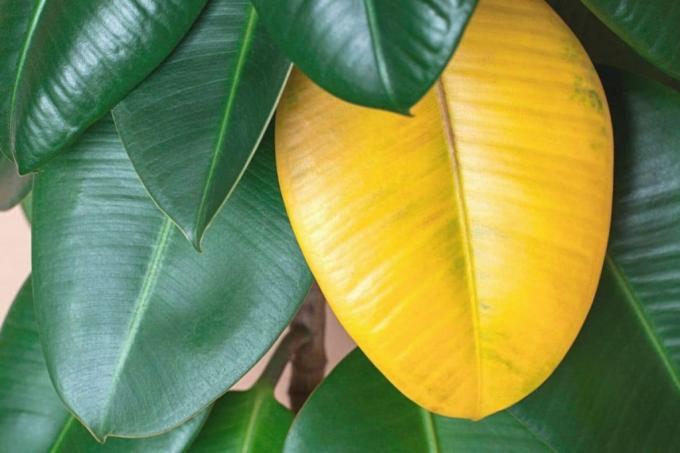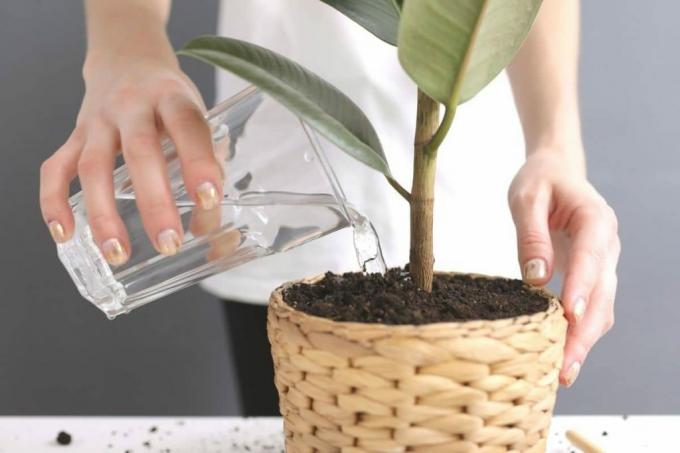
table of contents
- Causes and Actions
- Unfavorable location
- Check location
- Wrong pouring
- Fix water shortage
- Avoid waterlogging
- frequently asked Questions
Rubber trees are easy to care for plants. If you lose your leaves, something is wrong. The causes are manifold. However, you should get to the bottom of the matter quickly to avoid further damage. This helps with leaf loss on the rubber tree.
In a nutshell
- various causes cause leaf loss on rubber trees
- Check location, water supply and fertilizer application
- Rescue possible
- Avoid maintenance errors in the future
Causes and Actions
Mainly it is care errors that lead to the rubber tree losing leaves. These include:
- wrong location
- too little / too much watering
- incorrect fertilization
- Diseases and pests

Unfavorable location
Temperature and light
Rubber trees (Ficus elastica) feel good when their location is light and warm. Conversely, this means that they do not like something that is too dark and / or too cold. In addition to overall poor growth, the loss of leaves, which is constantly increasing, is another sign that Ficus elastica is dissatisfied with its place.
Since the understanding of warmth and brightness is different between humans and plants, a temperature of +18 degrees Celsius is already very cold for the rubber tree. If the thermometer shows a value below this, the plant perceives this as bitterly cold and is about to die of cold. The same applies to the brightness. Locations that humans classify as light are often already dark or even too dark for Ficus elastica.
Drafts

Rubber trees don't like drafts at all. In summer it is barely tolerated when the window is opened, but in winter the air flowing in is far too cold for the plants. If your Ficus elastica is not close to the window, you can recognize drafts as the cause of leaf loss by the fact that it only loses leaves on one side.
Check location
- Check the temperature at the location (day and night) and if necessary raise
- If there is not enough light, place the plant in a lighter and warm place
- Morning and evening sun are ideal
- shade the plant under blazing midday sun
Note: If he loses leaves after buying it, it does not have to be because he has been given an unfavorable location. Because the plants need some time to adjust to the new light conditions.
Wrong pouring
If it loses leaves, you should check the substrate of the rubber tree. If it is bone dry, the plant suffers from drought. If it feels damp or even wet, Ficus elastica has received too much water. Because both casting errors lead to the same result: he loses leaves.

Fix water shortage
This casting defect can be made up relatively well. It is important that you do not give the rubber tree too much water now. So keep calm and proceed as follows:
- Place smaller specimens with the pot in a bowl of lukewarm water
- remove when no more air bubbles rise
- Drain
- Place the plant in its usual location
- Water larger specimens moderately with lukewarm water for one to three days
- The substrate must slowly become saturated
- Check soil moisture
So that the rubber tree does not have to suffer from drought again, you should only water it according to its needs. If the damage occurred while you were away, you should inform your casting aid.
Note: It is true that the rubber tree does not suffer from dryness, but it can withstand dry periods better than wetness. You should therefore absolutely avoid waterlogging through too intensive watering!
Avoid waterlogging
A substrate soaked with water provides an ideal climate for fungi and bacteria. These attack the roots and thus severely disrupt the supply of water and nutrients to the rubber tree. Ficus elastica gives the impression of being thirsty and is poured all the more. This starts a vicious circle, which often results in complete loss of leaves or leaves. the death of the rubber tree ends.

In order for there to be any chance of saving the rubber tree, action must be taken quickly. How good your chances are can only be seen once you inspect the roots. Take the following measures:
- Carefully lift the rubber tree out of the pot
- Free roots from the earth
- Cut out rotten and rotten areas generously
- Rinse off remaining residue under lukewarm water
- let dry
- Repot Ficus elastica in dry substrate (use a new pot)
- do not pour
Now it takes patience because the plant must first recover from the weeks of moisture it has been exposed to. That is why the rubber tree may only be watered again when it looks fresh again.
Note: If his condition does not improve for weeks or months, you have lost the battle.
frequently asked Questions
Since the rubber tree is one of the weak consumers, the application of fertilizer is not a suitable measure. If you notice discoloration on the leaves, you may have already fertilized too much. Only fertilize moderately, not at all in winter.
Too much direct sunlight is one of the causes of leaf loss. Immediately give him a shady spot. You should also check that you have enough to drink.
Yes, that's why you should repot the rubber tree regularly. If it has completely rooted the old substrate, the supply of nutrients suffers. For repotting, it is best to choose a slightly larger container and replace the soil at the same time.
Diseases and pests, especially spider mites and scale and mealybugs, can also lead to leaf loss. As a rule, however, this is only the case when the infestation pressure is high. With a regular check, you should already have recognized the infestation beforehand.
